The Golf Club at CuscowillaEatonton, Georgia, United States
Architects: Bill Coore and Ben Crenshaw (1998)
6,847 Yards, Par-70
Rating/Slope: 72.2/132
My Quick Review: Amazing how much C&C can do with subtle land.
The Routing
The first hole is exceptional -- it's hard to imagine a better starting hole, especially given the dull nature of the land. The golfer becomes immediately acquainted with the striking bunkering at Cuscowilla as he is challenged to play boldly over the bunker on the left to leave a preferred angle of approach into the green. A reverse cambre fairway will accentuate the penalty of tee shots that are bailed out to the right.

The approach as seen from the centre of the fairway ~125 yards from the green shows how a single very well-placed greenside bunker and an angled green can impact decision-making back to the tee.

The first green is small and very titled from back-left to front-right, with contours that will help to accept shots played from the right side of the fairway. Missing long is a terrible mistake.


The 2nd hole is part of a long stretch of holes that continues through the short 5th that makes the golfer wonder whether Cuscowilla belongs in the discussion of Coore/Crenshaw's very best. Another reverse-cambre fairway at the 2nd that requires golfers play near the high side of the fairway to leave a much shorter carry over an angled bunker set into the lay-up area.

Interestingly, boldly playing over the carry-bunker offers only a shorter yardage as a reward, as the angle from the left side of the fairway is probably the preferred one.

A second wild and demanding green! It is hard to describe everything going on on this green, but a spine down the green's centre, a front-right knob, a back-right backboard and a back-left run-off make for many interesting pin positions.
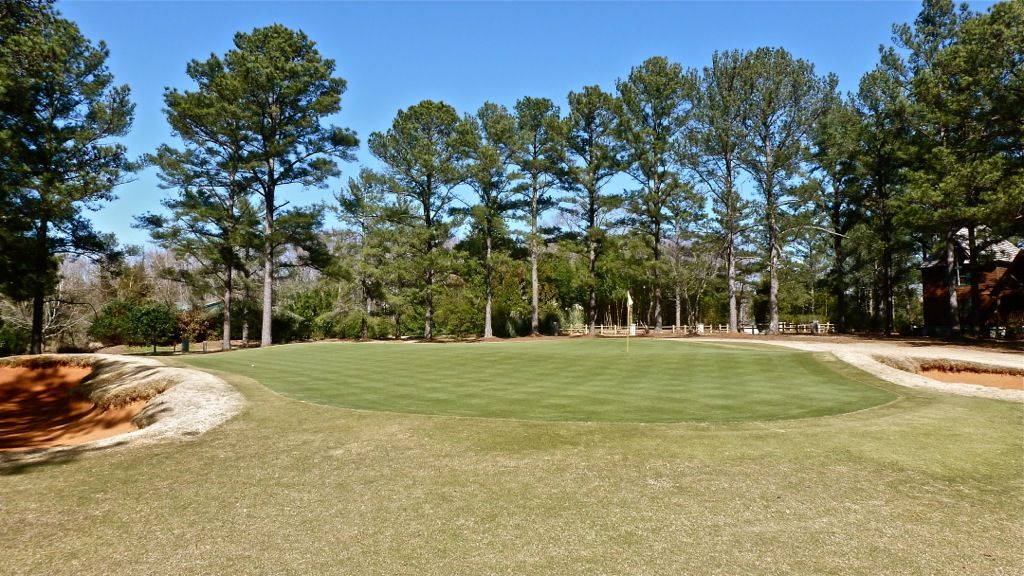

When reading Ran's earlier profile of the course, I noted his praise of the varied lengths of Cuscowilla's par-3s. An excellent observation, and I hit 5i, 3H, SW and 7i on the four par-3s. And not only are the lengths varied, but so are the shot requirements -- draw, low-fade, straight, high draw -- all four of the par-3s are strong holes individually are an ever better set.

The 4th hole at Cuscowilla is one of several holes that demands a forced carry over a water hazard. The tee shot is played into a tilted fairway that wants to collect balls to the right, but the preferred angle is from the high/left side. As is common of Perry Maxwell designs, a trade-off must be made between angle and distance.

The approach as seen from the right side of the fairway shows a green that falls off sharply on the right. Approaches from the left can more easily use the ground's contours to run the ball onto the green. Just steps over the putting surface is a lost ball. I found out the hard way.

The 290 yard par-4 5th was praised by Ran in his review for its strategic options, but according to my caddie that day, there is only one way to play the hole. A massive bunker protects the straight line to the green and requires a carry of some 250 yards, uphill, from the middle tees, making this a non-option for nearly everyone. There is a small blind fairway left of the bunker and a massive amount of width to the right of the bunker. In theory, I expect that the pitch from the left should be the easier one, but because of the sharp left-to-right tilt of the green, controlling a pitch from the left is near-impossible.


From the right, the view of the green is intimidating, but the golfer is playing into the green's tilt from here.

From the left the crowned putting surface is almost unhittable, especially with the predominant wind which is down and from the left.

A very long par-4 that moves gently to the left. Taking the aggressive line from the tee leaves the golfer with the option of running the ball onto a deceptively difficult putting surface. The 6th was cleverly routed along side and in opposite direction to the massive par-4 9th, ensuring that at least one of these two long par-4s would have different winds.

The approach as seen from the extreme left side of the fairway. Note the right-side bunker is set well-back from the putting surface.
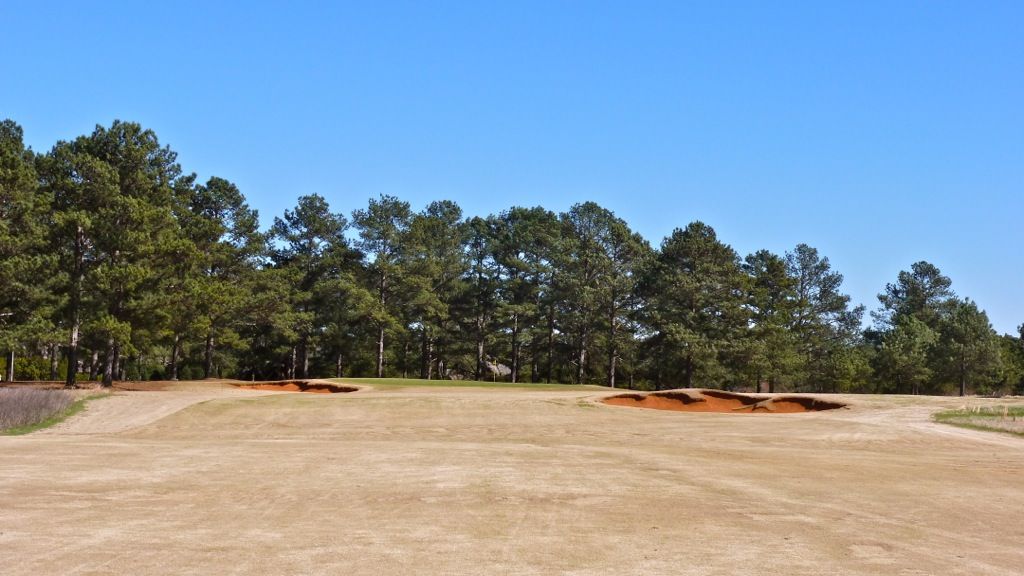
The golfer crosses a road to reach the 7th tee and is greeted with a very different style of golf hole once he reaches it. The 7th hole brings the golfer into the trees and towards some housing. The 7th hole is a short par-4 that requires precision from the tee -- finding the centre of the fairway leaves the only simple approach.

As seen from the right side of the fairway, playing too far to the right leaves an approach blocked-out by tree limbs. Not pictured, an approach from the left side of the fairway must negotiate the lone green-side bunker.

A false-front and a very sloped back-to-front tilt make the 7th green a deceiving challenge.

Dare I say it? The 230 yard 8th at Cuscowilla has obvious reverse-redan characteristics, as the hole is best played with a running fade landing on the kicker short of the green.
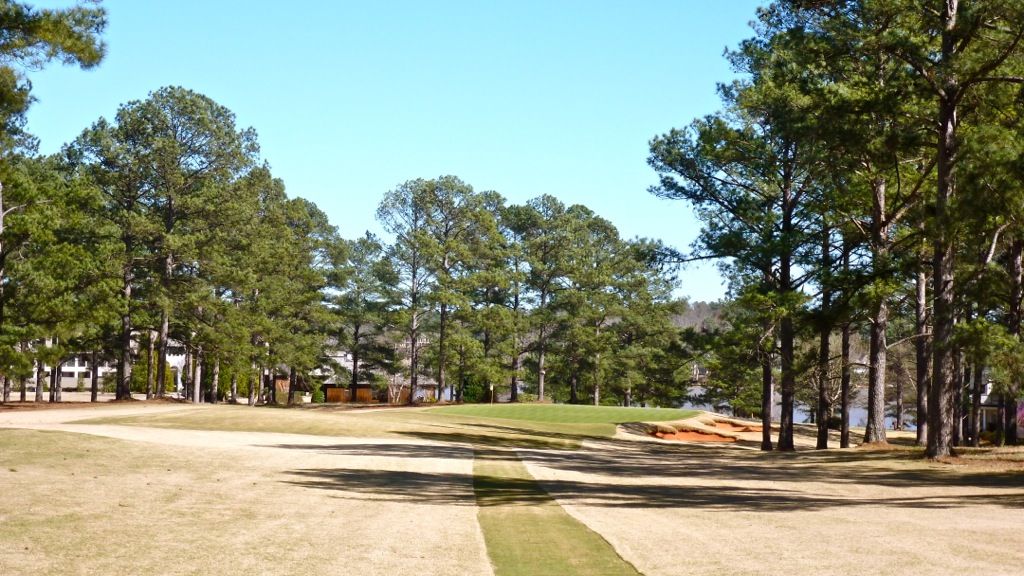
I have played many half-par holes, but the 480 yard par-4, which often plays into the wind, is closer to a par 4.9. After a fairly simple tee shot from a chute of trees, the fairway dips and then rolls, and a long drive will be rewarded with a much valued kick forward. Thankfully the green is open in front, though many will be laying-up on this difficult-to-reach par-4.

The tee shot at the 420 yard par-4 10th has a very similar look as the tee shot at the 4th. The strategy is very similar too. Once again the golfer must choose whether to take the bold line to the right to leave a shorter approach or whether to play to the left, from where the ground's contours are more easily used to approach the green.


The par-3 11th is a wonderful short hole. More than any hole on the golf course, the 11th is exposed to the wind and with an eternity green, the golfer is left questioning his club selection until his ball lands safely (or not!) on the putting surface.

The green is wildly contoured. A false-front and a back-left portion of the green that falls away are separate by a narrow and pinnable ridge that cuts across the green's centre.

After the openness of the preceding holes, the return to the forest at the 300-yard 12th can make the golfer feel claustrophobic. The golfer willing to play an iron has ample width to play to, but anyone hoping to leave just a pitch into the green must flirt with the trees on the left edge of the fairway.
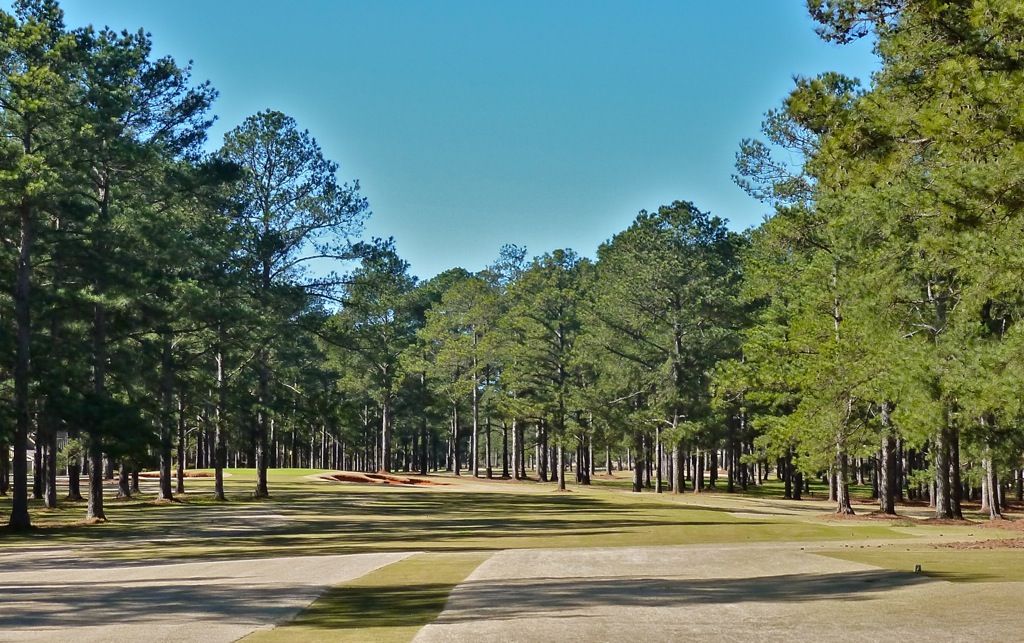
The difficulty of the approach from the right, though, encourages an aggressive play from the tee. As seen from the right-centre of the fairway, precision is demanded on the approach as the golfer must carry a fronting bunker, but absolutely must not end-up above the hole.

The green at the 12th is tiny and domed and predominantly tilted back toward the tee. I am sure putting from above the hole to off of the front of the green is a regular occurence. That being said, my group managed to head to the 13th tee with a total of 1 putt!

The 13th is routed in the same direction as the 12th and my caddie suggested that Ben Crenshaw once called this best par-4 he ever designed. The hole sits on flat land and is constrained somewhat by trees, and is subtle in its shot demands. An open green front suggests an easy approach but the land will move approach shots to the left and down an embankment next to the green.
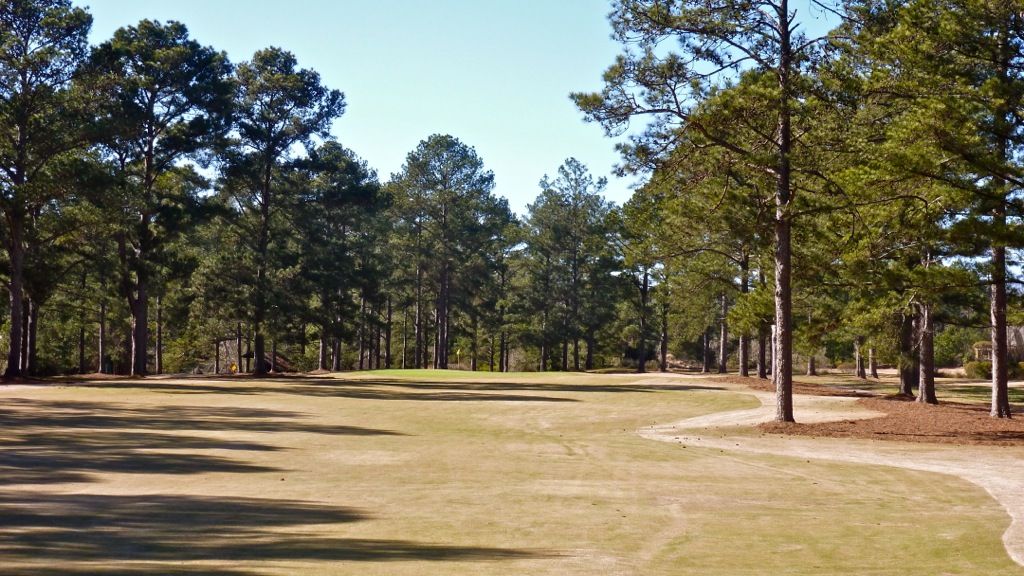

The 600 yard 14th must be the most controversial hole at Cuscowilla. For mine, it is a wonderful par-5 that challenges the golfer to play aggressively on each of his three shots. From the tee, golfers can play safely away from the water on the right, but a bold tee shot down the left may kick forward and reward the golfer with much needed yardage.

The second shot is a handful. Some golfers will choose to play short of the pair of bunkers 175 yards from the green, but golfers hoping to hit the green in regulation must challenge them. Either play well away from the bunkers and leave a long and blind approach to the green, or skirt them and the golfer will be rewarded with the only clear view of the green.

After a very bold second shot, the golfer will have this view of the green:
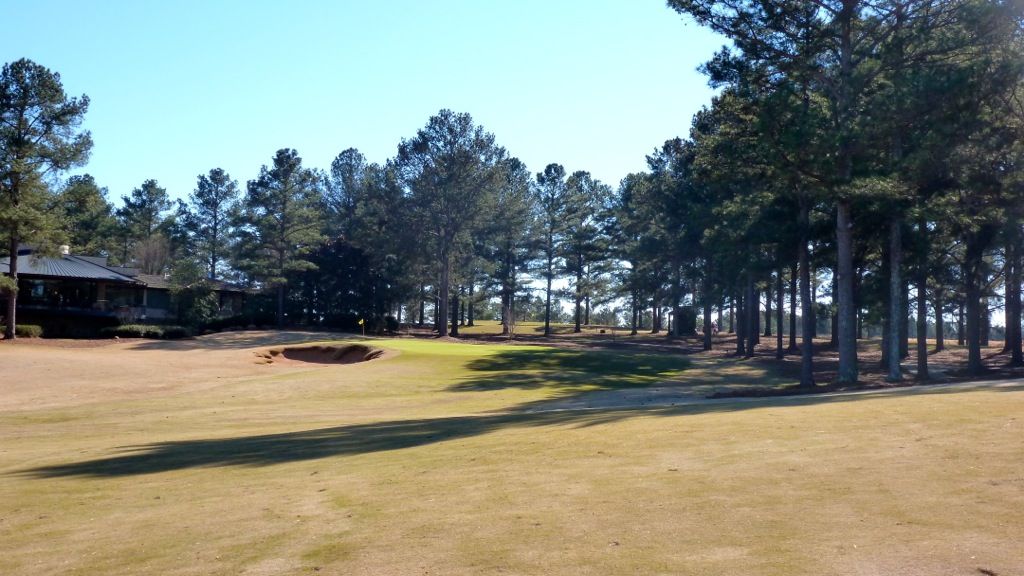
The stretch of holes from 13-15 total over 1500 yards, and much of it plays uphill!

The primary interest in the 445 yard 15th is found at the green, which has sharp internal contours.

The 16th is a mid-length par-3 that is just short enough to tempt most golfers to play foolishly towards pins that are left of centre. The golfer is offered plenty of room to bail out to the right, and he should choose to favor that side as the tilt of the green means any miss to left guarantees bogey.

The finish at Cuscowilla disappointed this author. The 17th is a reverse dogleg 400 yard par-4 that bends lift and up a hill.

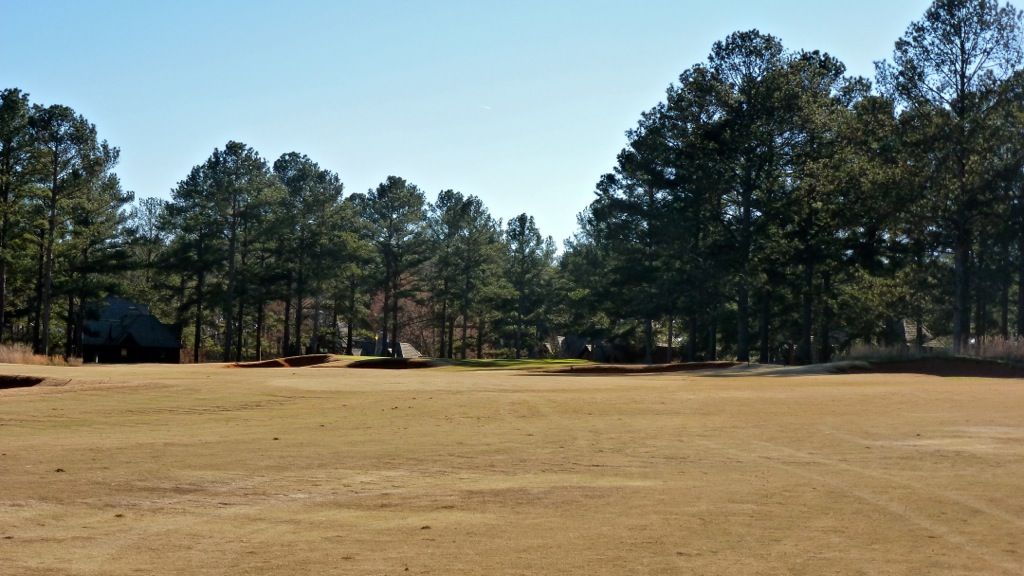
The closer is a massive par-4 that plays over rolling terrain. Cleverly, the 18th and 9th, both very long par-4s, are routed in opposite directions to ensure varied wind directions and yet somehow both played into a strong headwind on the day I played. Neither I nor my playing partner could get anywhere near either green in regulation.



















































